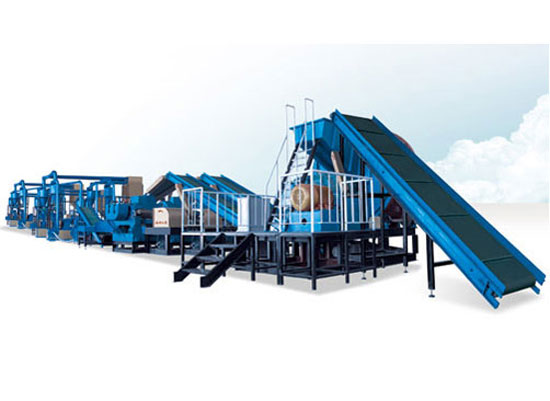Beside recycling waste rubber by rubber pyrolysis plant, Beston has also developed the rubber powder production line for sale, which is another method to efficiently deal with waste rubber products. The plant mainly consists of mainframe and auxiliary engine, which is specialized equipment to process waste rubber products and waste rubber tires into rubber powder.

The whole rubber recycling plant has a perfect facility which includes the base, frame, roller, drive gear, reducer, adjusting device and so on. The roller temperature device and the electric control system are also its special devices. In addition, the roller iron material is the chilled cast iron alloy, which is durable and hard. Besides, the rubber powder from waste tyres has special advantages. For example, it conduces to saving energy. As we all know, energy crisis has become more and more serious in each country, while the invent the rubber powder production lines can replace the raw rubber to produce higher value rubber products. On the other hand, this kind of technology can be called green production, because there is no pollution in the productive process, which has responded to the national environmental protection policy.
Applications of the rubber powder from used tyres:
The waste tire powder has wide applications, of which the rubber powder can be made into rubber powder modified asphalt for highway construction. It is the largest consumption of rubber powder application market. We can customize appropriate equipment according to different needs. Final products from the tyre powder production line:

1. TDF (about 50mm): raw material for pyrolysis plants or power generation;

2. Rubber particles (1-4mm): mainly used for producing rubber powder modified asphalt or rubber floors;

3. Rubber powder (30-200 mesh): used for making reclaimed rubber or rubber products and so on.
Major parts of rubber powder machine:
1. Single wire drawing machine

| Model | 1200 |
| Capacity | 30-60 strips/h |
| Size of waste tyre | ≤ Ø1200 mm |
| Power | 7.5kw |
| Operating pressure | 15T |
| Cylinder stroke | 1300mm |
| Weight | 16.T |
| Physical dimension | 3150*750*1400mm |
2. Jaw Type Tyre Cutting Machine

| Model | J-3000 |
| Capacity | 60 strips/h |
| Size of waste tyre | ≤ ?3000 mm |
| Power | 18.5KW |
| Operating pressure | 380T |
| Weight | 25T |
3. Comprehensive Tyre Shredder

| Model | 900 | 1200 |
| Capacity | 2t/h | 4t/h |
| Size of waste tyre | ≤ ?900 mm | ≤ ?1200 mm |
| Product specifications | 50*50mm | 50*50mm |
| Power | 20*2+1.5+0.5kw | 45*2+1.5+1.5kw |
| Physical dimension | 2000*2500*2800mm | 4000*3400*3700mm |
| Weight | 6.8T | 18T |
4. Belt Conveyor

| Model | D-13000 |
| Capacity | 0.1-10t/h (Adjustable) |
| Conveying length | 4-10m |
| Conveying height | 1-5m |
| Conveying width | 500-1300mm |
| Conveying speed | 10-30m/min |
| Power | 1.1-3KW |
| Weight | 1.6T |
5. Coarse Crusher

| Model | CS-1000 |
| Capacity | 800-1600kg/h |
| Feeding size of rubber | 50*50mm |
| Size of products | 2-15mm |
| Power | 37KW |
| Physical dimension | 2000*1800*2500mm |
| Weight | 2T |
6. Fine crusher

| Model | XS-300 |
| Capacity | 1.5-2.5t/h |
| Feeding size of rubber | ≤20mm |
| Size of products | 2-3mm |
| Power | 30KW |
| Physical dimension | 1400*1100*1900mm |
| Weight | 2T |
7. Screw Conveyor

| Model | LS-70 |
| Capacity | 0.5-1.5t/h (Adjustable) |
| Conveying length | 3-8m |
| Speed | 60m/min |
| Power | 1.1-3KW |
| Weight | 0.8T |
8. Coarse Fiber Separator

| Model | CXF-70 |
| Capacity | 0.4-1t/h |
| Raw material | Rubber granules, fiber |
| Efficiency | ≥96% |
| Power | 7.5KW |
| Quantity of exhaust inlet | 2 |
| Weight | 1.5T |
9. Rubber Powder Classifier

| Model | FJ-1000 |
| Capacity | 0.3-0.8t/h |
| Speed of main shaft | 15-1200r/min |
| Granularity | 15-150mesh |
| Power | 7.5+1.1KW |
| Efficiency | 98% |
| Weight | 1.3T |
10. Rubber Vibrating Magnetic Separator

| Model | CS-1000 |
| Capacity | 0.5-1t/h |
| Speed of main shaft | 300-1200r/min |
| Granularity | 10-150mesh |
| Power | 0.55 KW |
| Efficiency of iron removal | 99% |
| Height | 100-200mm |
| Weight | 1.3T |
Summary
So in totally, the rubber powder from tyre waste has a wide range of applications in our surrounding environment. It has become more and more popular in construction area, automobile manufacture fields because of its low investment, no pollution, high economic benefits.


